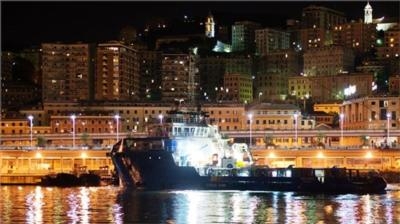Fri, Oct 10, 2014
Recovery Vessel Traveling From The Mediterranean To The Pacific Ocean
The Nos Aries received a special send-off at the 54th International boat show in Genoa as it began its long journey across the Mediterranean Sea and the Atlantic.

A team of mission engineers will board in Panama and from there sail through the Panama Canal and into the Pacific.
First, they will check the ship’s antenna and telemetry receivers are working properly after the long journey. The autotracking of the antenna that will pick up the signals from the Intermediate eXperimental Vehicle on its flight back to Earth will be checked by following low-orbit satellites.
Although the team have already practised the tricky manoeuvre of lifting IXV out of the ocean, they will continue to hone their skills under a wide range of conditions.
Nos Aries , the Mission Control Centre in Turin and ESA’s Spaceport in Kourou, French Guiana will be linked up via Inmarsat satellite for IXV mission simulations using voice, data and video. The crew will also take part in a dress rehearsal of the launch, three days before the actual liftoff.
The ship will reach its destination four days before the flight, slightly north of the equator, on a circle 25 km from the target landing spot. This distance guarantees the safety of the ship while allowing maximum telemetry reception and rapid access to IXV after splashdown.
On flight day, the ship will release weather balloons to check the wind conditions over the Pacific to provide information on IXV’s descent path. If sea conditions allow the launch to go ahead, Nos Aries will receive the readings from IXV’s 300 sensors during descent and then pick up the beacon signals to pinpoint the craft in the water.
Divers in speedboats will approach the floating craft and then stand back as sniffer devices check for residual propellant fumes. On the all-clear, the recovery cranes will carefully hoist IXV to safety before the fuel tank is cleaned out for the journey home to Europe.
Lofted by a Vega rocket, IXV will test the technologies and critical systems for Europe’s future automated reentry vehicles returning from low orbit.
(Image provided by the European Space Agency)
More News
He Attempted To Restart The Engine Three Times. On The Third Restart Attempt, He Noticed That Flames Were Coming Out From The Right Wing Near The Fuel Cap Analysis: The pilot repor>[...]
Make Sure You NEVER Miss A New Story From Aero-News Network Do you ever feel like you never see posts from a certain person or page on Facebook or Instagram? Here’s how you c>[...]
From 2009 (YouTube Edition): Leading Air Show Performers Give Their Best Advice for Newcomers On December 6th through December 9th, the Paris Las Vegas Hotel hosted over 1,500 air >[...]
Aero Linx: NASA ASRS ASRS captures confidential reports, analyzes the resulting aviation safety data, and disseminates vital information to the aviation community. The ASRS is an i>[...]
“For our inaugural Pylon Racing Seminar in Roswell, we were thrilled to certify 60 pilots across our six closed-course pylon race classes. Not only did this year’s PRS >[...]
 NTSB Final Report: Rutan Long-EZ
NTSB Final Report: Rutan Long-EZ ANN FAQ: Turn On Post Notifications
ANN FAQ: Turn On Post Notifications Classic Aero-TV: ICAS Perspectives - Advice for New Air Show Performers
Classic Aero-TV: ICAS Perspectives - Advice for New Air Show Performers ANN's Daily Aero-Linx (06.28.25)
ANN's Daily Aero-Linx (06.28.25) Aero-News: Quote of the Day (06.28.25)
Aero-News: Quote of the Day (06.28.25)



